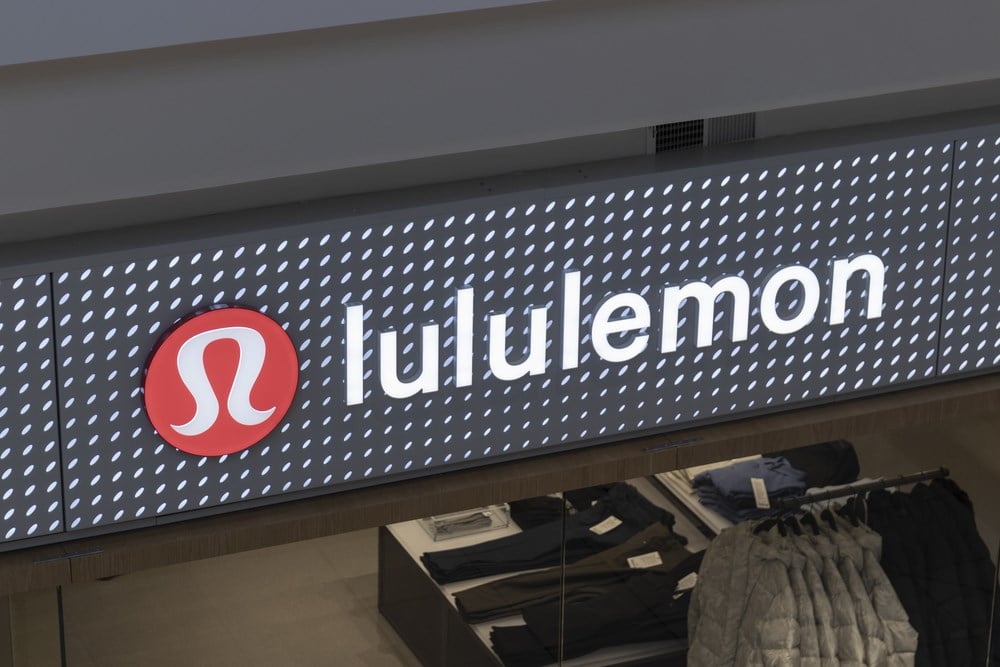
Lululemon Athletica Inc. (NASDAQ: LULU) closed 10.31% higher on October 16 in monster trading volume on news the company was joining the S&P 500.
The retailer of athletic and leisure clothing is replacing Activision Blizzard, which is no longer a publicly traded company after NASDAQ: ATVI">Microsoft Corp. (NASDAQ: MSFT) completed its acquisition of the video game publisher on October 13.
The changes will be effective before the market opens on October 18.
With the big move-up, Lululemon shares rallied to their best levels since December 2021.
If you look at MarketBeat’s Lululemon Athletica chart, you’ll see that the stock has been edging higher this year, posting a 17.89% 2023 gain.
Lululemon Clothes Racing off Shelves
The company’s athleisure clothing has been running and jumping off the shelves, as the company has notched revenue increases of 18% or higher in the past eight quarters. Earnings have grown at rates ranging from 22% to 54% during that time.
You can see that growth using MarketBeat’s Lululemon Athletica earnings data.
Net income grew every year since 2017, with Wall Street eyeing earnings growth of 21% this year, to $12.17 a share. Next year that’s expected to increase by another 15% to $13.98 per share.
The company is continuing to expand its product lines, as well as its geographic footprint while maintaining a focus on the core line of clothing. The business of athletic clothing is highly competitive, with major rivals including Nike Inc. (NYSE: NKE) and Under Armour Inc. (NYSE: UAA).
Expanding Into Fast-Growing Chinese Market
Earlier this year, Lululemon said it had plans to open more than 30 stores internationally, with the majority slated for the fast-growing Chinese market, where revenue is increasing at a faster pace than in the U.S.
Net revenue increased 11% in North America and increased 52% internationally.
That doesn’t mean there are no plans for U.S. growth. For example, the company is currently building a larger space at upscale shopping area ABQ Uptown in Albuquerque, New Mexico.
Lululemon is also expanding into other lines of business, as the company demonstrated by inking a five-year deal with troubled fitness gear maker Peloton Interactive Inc. (NASDAQ: PTON).
Buying Demand from S&P 500 Inclusion
When a stock is included in the S&P 500, it often rallies due to increased demand from index-tracking funds and institutional investors.
Inclusion in this widely used index can be seen as a mark of stability, but that’s legitimate; mutual funds and exchange-traded funds tracking the S&P 500 buy shares, so that can result in a more sustained rally.
Lululemon will be part of the consumer discretionary sector, tracked by the Consumer Discretionary Select Sector SPDR Fund (NYSEARCA: XLY).
MarketBeat’s Lululemon Athletic analyst ratings show a consensus view of “moderate buy” on the stock, with a price target of $441.93, an upside of 6.07%.
Electrical Gear Maker Also Joins Index
Lululemon isn’t the only stock being added to the S&P 500.
Electrical gear maker Hubbell Inc. (NYSE: HUBB) is also joining the benchmark index, replacing Organon & Co. (NYSE: OGN), a pharmaceutical whose market capitalization has fallen to $4.308 billion.
That’s pretty small, relative to the larger companies in the S&P 500. Organon is joining the small-cap S&P 600 index.
Hubbell, whose market capitalization is $16.31 billion, is being bumped up from the S&P 400 mid-cap index.
Within the S&P 500, Hubbell will be a component of the Industrial Select Sector SPDR Fund (NYSEARCA: XLI).
Hubbell shares rose by $3.13% on October 16, closing at $304.03 in more than double average turnover.
Industrials Move More Slowly than Retail
There are simple reasons why Hubbell didn’t skyrocket at the same rate as Lululemon: Industrials are typically slower moving, especially during economic upswings.
In addition, a maker of electrical equipment for the industrial and construction market isn’t as exciting as a fast-growing athletic clothing retailer. Wall Street analysts are susceptible to hype just like retail investors, but both sectors have their unique drivers and patterns of growth.
The Hubbell dividend yield is 1.47% and the company has a 15-year track record of boosting the shareholder payout, landing it a spot on MarketBeat’s dividend achievers list.





